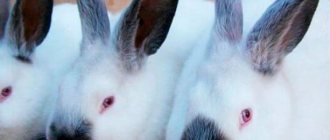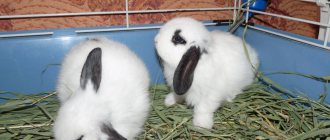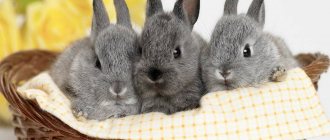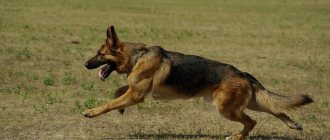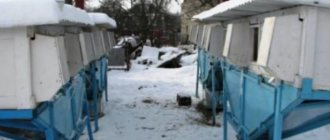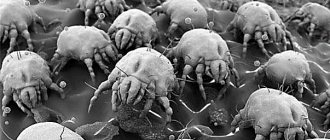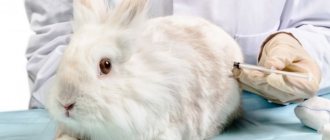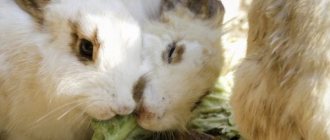Does it all depend on the breed of rabbits?
I am often asked: “What is the most profitable breed of rabbit to breed?” I always answer that all breeds of rabbits are worthy of attention, that the main thing is not the breed, but how the rabbit breeder approaches the matter, how conscientiously he does his favorite pastime. Business or making money from rabbits is different from many others in that you are dealing with living beings who have their own habits and quirks, likes and preferences, their own weaknesses and propensities for diseases, and in the end, their own character. Therefore, you need to promote your business taking into account this small remark. You can familiarize yourself with some of the most popular breeds of rabbits and their characteristics on my website. In general, of all the existing breeds of rabbits, no more than 20 are actively bred all over the world. I suggest first looking at what the main breeds of rabbits look like. To do this, simply go to the photo gallery of the site.
Meat breeds
The most profitable direction in rabbit breeding is considered to be the breeding of meat breeds. They are actively gaining weight, their meat has high taste.
The breeds that provide the best economic effect are called broiler breeds. The most popular types in our country are:
New Zealand (white and red)
The hardy, fertile breed can easily tolerate temperature changes. Animals reach maximum weight (4-5.5 kg) in a short time, which is the main advantage of New Zealanders. They live up to 8-10 years.
Californian
It is distinguished by its fleshiness without excess fat and thick white fur with dark markings on the face, tail and paws.
With a strong, folded physique, the animals reach 5 kg of live weight. The fertility of females and the rapid growth of young animals are no different from New Zealanders.
Burgundian
The dominant feature of the species is extraordinary fertility. In one litter, the female brings 10-12 babies.
Active growth and reactive puberty occur largely due to strong immunity and a strong body.
The uniform yellowish-red color is the hallmark of the Burgundy breed.
What can influence the choice of breed?
I would like to make a reservation right away that in the future I will keep in mind the meat direction of breeding; for those interested in the skin direction, I can advise you to take a closer look at the unsurpassed Soviet Chinchilla, as well as the Rex breed. The commercial value of the skins of these rabbits is on par with mink ones.
You can get some idea about the preferences of your fellow rabbit breeders from our statistics. The information we collected from 2012 to 2021 is archived at https://servis-oprosov.ru/poll/1142/. Almost 20 thousand rabbit breeders from all regions of the former union took part in the survey. If you wish, you can participate in the creation of a database of new, more complete statistics. Anonymity, as it should be, is guaranteed.
HINT: 1. Indicate the breed(s) of rabbits you raise. (If you breed more than one breed, left-click on several squares opposite them.)
To do this, check the required boxes. 2. Click on the “SEND” button at the bottom of the list and click “View previous answers” in the window that opens. 3. Do you just want to look at the statistics? Just skip the first point of these instructions.
The choice of breed, of course, depends on the conditions of their keeping and the breeding method. All breeds of rabbits were purposefully bred for a specific climate zone and mainly for keeping in ordinary cages. And if these conditions are changed in the future, the rabbit will feel, to put it mildly, uncomfortable. Considering the above, I advise you to find out what kind of rabbits are bred in your region. You can get more complete advice at your nearest rabbit nursery. By the way, it is also the best place to buy rabbits for breeding.
For example, the Western European giant Flanders takes root very poorly in the vast expanses of the former Soviet Union; its maintenance requires special heated cages, which is becoming more and more problematic in conditions of constantly rising energy prices. Our rabbit breeders are increasingly paying attention to the White and Gray giants adapted to local conditions. They are, of course, inferior in size to Flanders, but they are unpretentious to food, prolific and tolerate the winters of central Russia well. As for a more severe climate, no one here will give you a guarantee of successful breeding. Giants and giants are not suitable for breeding in pits. Practice shows that rabbits that are in the middle dig holes better. But giants are perfect for balconies and loggias, here they get warmth, an individual approach and “food made to order.”
Gray Giant and its features
Individuals of this breed have a strong, rough constitution, a massive, strong body with a slight dewlap. Body length reaches 66 cm, chest circumference behind the shoulder blades up to 39 cm. The croup is rounded and wide, the head is large with large erect ears. The breed is characterized by several colors: gray-hare, dark gray, ferruginous gray, etc. The coat is dense and has zonal toning like agouti.
Gray Giant
The difference between the Gray Giant and other meat breeds is in early maturity, quality of meat and carcass, and high resistance to various types of diseases. A rabbit already at 3 months weighs 2-2.5 kg if it is on complete feed. In this case, the female must feed the offspring for up to 6-8 weeks.
Raising Gray Giant rabbits does not require complex manipulations. They are adapted to normal housing and feeding conditions. Large wooden cages equipped with drinkers and feeders are perfect for this.
The return on feed is higher for “average” rabbits.
Look for medium-sized rabbits (sometimes called medium-large). After all, as for the cost-effectiveness or, as they say, the payback of feed, not everything is clear here either. This largely depends on the feed itself. For example, on farms in Europe, the use of balanced granules has long been practiced, which completely cover all the needs of the rabbit’s body. In fact, they only feed him pellets and also provide him with water. It turned out that with such feeding it is more profitable to breed rabbits of medium breeds. Their digestive system is more suitable for intensive feeding, they gain weight faster, are quite fertile, and their maternal instincts are well developed.
The conclusion of the Europeans is clear: when feeding with pellets, the return on feed is higher for “average” rabbits. Our rabbit breeders also actively breed medium-sized rabbits - butterflies, Vienna blues, Californians, New Zealand reds and whites... The difference in the reproductive capacity of animals also plays in favor of this. After all, the more often the female rabbit hunts, and therefore becomes pregnant, the shorter the time cycle of “downtime” without the delivery of products. It is estimated that a medium-sized female goes into heat on average on the 125th day, and a large female on the 180th day. Giant males also mature about a month and a half later than their average counterparts.
The quality of the skins is noticeably superior to that of the middle peasants. You can view and compare specific figures by visiting the corresponding pages of our website.
Silver rabbit
From Champagne rabbits imported from Germany, through the efforts of Soviet breeders, the Silver rabbit breed was developed through selection in 1927.
The body of the silver rabbit is cylindrical in shape with good proportions and quite harmonious in structure. The chest is deep and wide, the body itself has a straight back, and the sacrum area is powerful and well developed. Its body is almost 57 cm in length. An adult rabbit's chest girth, measured at the shoulder blades, is 36 cm. The average weight of individuals is 5 kg.
The skin of a silver rabbit has an old silver tint due to the combination of the color of the main types of hair and down. The paws, nose, ears and tail only highlight the uniform distribution of color over the body, since they are somewhat darker, but the color remains silver.
This breed has a meat yield at slaughter of 60%. This type of rabbit can also boast of its fertility; with each litter, the female rabbit brings at least 6-8 cubs. Connoisseurs value Silver rabbit meat for its wonderful taste.
Animals of this breed do not require special care; they are very unpretentious and adapt well to various conditions.
Advantages of white (albino) rabbits.
You can save a little more when breeding rabbits if you get albinos. There are several such breeds. Here are just a few: White New Zealand, White Pannon, white giant. Here, with a certain amount of truth, we can add the Californian with a Butterfly. This entire cohort is distinguished by a calmer disposition and does not expend extra energy on fighting and running around. This means that less feed will be required to maintain and gain weight. The fat layer also grows noticeably easier. All large farms mainly focus on albinos. (See video below).
Soviet chinchilla
The breed was developed by breeders from two regions, Novosibirsk and Saratov, together with the Research Institute of Fur Farming and Rabbit Breeding. The breed was obtained by crossing and by strictly culling the imported chinchilla and the White Giant rabbit. This breed received official status in 1963 and is valued for its meat and beautiful skins.
The harmonious body structure of the Soviet chinchilla is expressed by its slender and wide body with a small head and small ears standing straight. On the lower part of the abdomen, neck and tail below, the skin is white, in contrast to the whole body of a bluish-gray color. The fur is very smooth with a peculiar shine. The skins of the Soviet chinchilla are very similar in color to the natural fur of the animal of the same name.
An adult individual has an average live weight of about 5 kg, its body length is 57-62 cm, and its chest girth at the shoulder blades reaches 38 cm. Fertility is good, but low, with no more than eight cubs in each litter. High growth rates are noted; after 3 months, the young generation gains weight up to 4 kg. It is characterized by a high slaughter yield of meat from 56 to 63% of the total weight of the rabbit.
Global trend in rabbit breeding.
If you look at the average statistics, then throughout the world as a whole, giant rabbits have lost their leading positions, even in those countries where they were bred and were considered a national treasure.
California rabbit.
In recent years, the rating has been maintained by Californian and New Zealand rabbit breeds. And this is also directly related to the emergence of new technologies and new types of feed. And what can we add if a female weighing 4.5 kilograms regularly brings 8 rabbits, which after 3 months look like adults with a slaughter weight of about 3 kilograms? Interestingly, cases of any individual rabbit gaining weight of more than 5 kilograms are not welcomed and are regarded as wasteful use of funds. It’s a paradox, but here the rule “the more, the better” does not work. Giant rabbits are increasingly moving into the category of decorative pets. They have an easy-going character, a calm disposition, and are sociable with their owners.
Viennese blue rabbit
By inheritance from the Flanders, this rabbit received the same physique, but only of increased density with an elongated body and strong bones, a back with a rather wide loin. The head is of medium size, with wide, straight and not thick ears.
The fur of the Viennese rabbit is a beautiful bluish-blue shade, which is distributed evenly throughout the body without any inclusions of another color. Thick and fluffy, it is much better than the fur of other breeds and is well suited for simulating the skin of a cat.
In terms of fertility and milk production, females are inferior to female Burgundy and California rabbits; in terms of early maturity, the weight of a young rabbit reaches 70% of the weight of an adult by only 4 months. The slaughter yield of meat is also below the norm for meat breeds.
Is everything acceptable to us?
You may ask why we still have such a strong position of giant rabbits. Primarily due to the high cost of pelleted feed. It is much more profitable for our rabbit breeder, especially the small one, to feed the rabbits with grass, hay, branches and mash with grain waste. Our giants assimilate them well and do not gain fat for a long time, maintaining their reproductive ability. Established habits and traditions still play a big role. If the farm is doing well, it brings a stable profit, sometimes it is quite difficult to “break yourself” and start a new breed.
| Subscribe to our website's weekly newsletters: ✦ BROTHER RABBIT ✦ Current notes on keeping rabbits are waiting for you. SUBSCRIBE |
Giant rabbits are perfect for Mikhailov’s mini-farms, which were “tailored” for this breed. However, this technique is already more than 20 years old and, despite all its attractiveness, it has not gained much popularity. In Western European countries, newer farms have already been developed and implemented, where there is complete automation and mechanization and where medium-sized rabbits are raised. Most of our fellow citizens cannot afford them. What are heating and artificial insemination alone worth? For those who are interested in Western technologies of intensive breeding, I can recommend watching a short video:
Please share this article with your friends on social networks:
Please rate the article. Ask a question, discuss on the forum.
Downy
White down
Despite its name, this breed includes several types with different colors (they are also black and blue), coat quality and body weight. Typically, adults grow up to 55 cm in length and weigh 4 kg. The fertility of rabbits is average and no more than 7 rabbits are born in one pregnancy. Over the course of a year, males bring up to 700 g, and females - up to 1 kg of delicate, elastic and durable fluff. In general, the breed is very hardy and adapts well to almost any climate.
Angora down
Rabbits of this breed are often used as pets due to their fluffy fur, playful nature and weight of up to 3 kg. Angoras need dry and spacious cages and regular grooming.
